| Lesson 5 | Marketing implications |
| Objective | Define the Implications and Relevance of Marketing related to eBusiness and the Enterprise |
Implications and Relevance of Marketing related to e-business
The world of e-business is fundamentally evolving because of new technology.
Consequently, there is dynamic change in the array of technologies available, the features of the technology, and the cost of the technologies.
The key issue for the marketing area of the company to address is the e-business branding and how this is implemented. Not surprisingly, the customer's perceptions in e-business are as important as they have always been for conventional business: the perceptions of the business are as important as what the business actually delivers. For example, for an online travel agency, consumers' perceptions about ease of use, flexibility, and security can be huge hurdles for the e-business to overcome.
The key issue for the marketing area of the company to address is the e-business branding and how this is implemented. Not surprisingly, the customer's perceptions in e-business are as important as they have always been for conventional business: the perceptions of the business are as important as what the business actually delivers. For example, for an online travel agency, consumers' perceptions about ease of use, flexibility, and security can be huge hurdles for the e-business to overcome.
- Branding and e-business:
The ultimate concern for the marketing department is branding of the e-business, specifically, if a new brand will be required for the e-business. The answers to the following questions will help answer this all-important question:
- Is the e-business to be an extension of the existing company or a new entity on its own right from a marketing point of view?
- Will the existing brand transfer to the e-business environment?
- Is the e-business likely to be competing with the old business for customers, or is the e-business complimentary to the old business?
If a new brand is required, then it is advisable to involve resources that are experienced in what works and what does not work for branding in the e-business environment. - Marketing for e-business:
There are many differences between acceptable/desirable marketing practices in the real world and in e-business. The following series of images below describes the needs of e-business marketing.
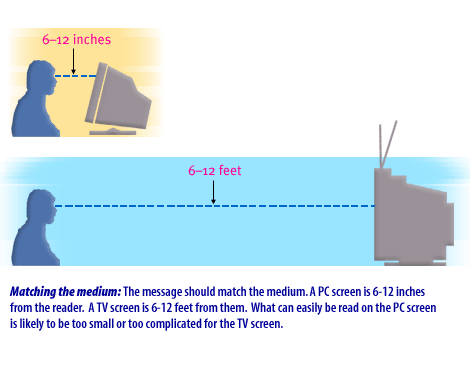
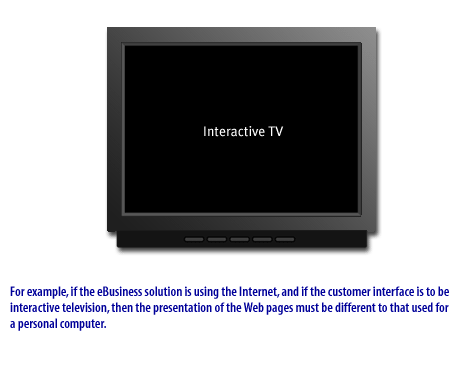
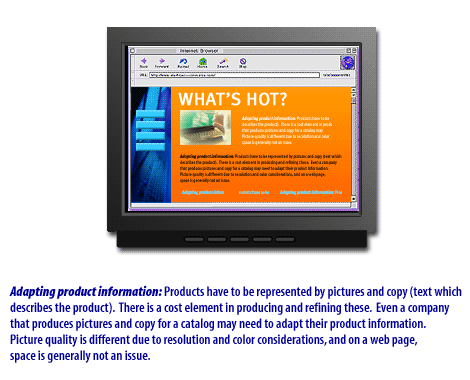
Advanced Digital Marketing Strategies
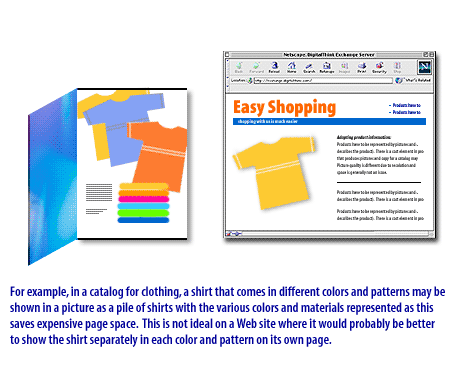

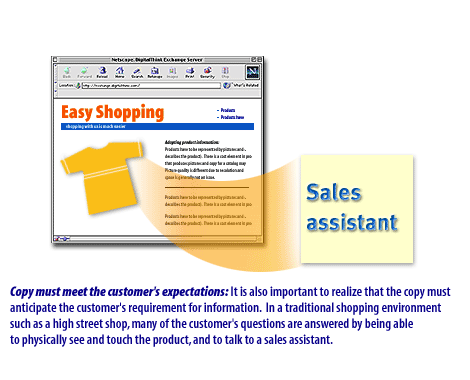
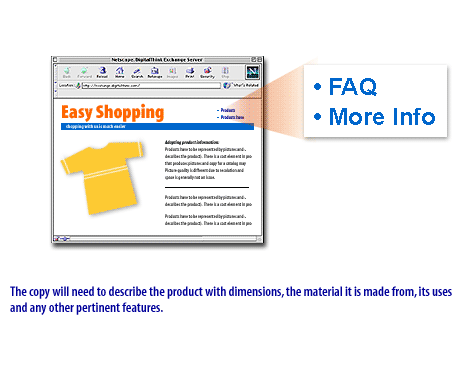
Tracking Customer Activity
eBusiness presents a larger-than-life opportunity to gather a far greater amount of customer activity information. As invaluable as this opportunity is to the marketing function, the interpretation of the data requires a level of understanding by the marketing department, of the eBusiness solution. If this information is interpreted correctly, the end result can be a much faster and more successful reaction by the marketing department and the company as a whole to customer requirements.
Information can be exploited far more readily online than it can be in the real world.
Everything about the customer can be recorded, for example, which ads they click on, which pages they visit, and how long they spend there.
-
What Cookies are and why they are used?
Cookies offer a tremendous opportunity to harvest information about customer activity. But what are cookies, and how do they work? What are cookies? A cookie is a message given to a Web browser by a Web server. The browser stores the message in a text file called cookie.txt. The message is then sent back to the server each time the browser requests a page from the server. What do they contain? This text may be as simple as to identify the user as "Jane" or in some cases, it will contain their actual information if they have provided it: their email address, phone number, your physical address. How are they used? Cookies are used to remember passwords, to make shopping carts remember" what you've bought, and to "switch them off" Cookies, when properly used, can significantly add to the user experience, making it more personal and enjoyable for the user, and often more profitable for the company.
The use of cookies to record surfing behavior is a highly contentious issue, particularly on the grounds of privacy, as they may be used without the knowledge and express consent of the user.Cookies and privacy Existing regulations, targeted at protecting personal information, limit the use and application of cookies. The architect should be aware of these regulations, and initiate discussion with the legal department about the planned use of cookies on the site. Cookies on your site One way to increasing return on online advertising is by revenue sharing. Revenue sharing is when one site drives traffic for another site by promoting it on theirs (and vice verse). The site being promoted gives the other a portion of their ad revenue. The only way to measure this is by cookie tracking.
You also need a way to measure how effective direct emailings are, measure how proposed site redesign affects user behavior, and count the number of first-time visitors. - Purpose and Function
Purpose Questions Explanation Track behaviors Track future viewing How many, and which pages are viewed How frequently are users who are getting direct email viewing this mail? What is the aggregate data for the number of users viewing pages? Cookies are also useful for tracking mailings. If you use an email service to deliver your site's frontdoor to consumers, who can then click on the links to get to your site. If the site driving traffic gets paid for every ad they serve for the other site, the number of of pageviews must be counted to determine if this is how people are "clicking through" to getting to the site.
The number of pages they view in a single session, as well as how long they save these inbox messages, and how often they access them will need to be calculated.
Frontdoor: The index or home page on a Web site.Measure how proposed site redesign affects user behavior For two versions of the home page or frontdoor, how much time is each group spending viewing pages? If you wanted to change your home page, but were undecided as to which of two options to choose, youcould provide both versions and a survey users about which they prefer. Or you could, using a random-sampling, provide one version to one group, and the second version to a second group, and measure, on average, which group spends more time and views more pages. This is the fairest test, and one that only works with cookies. Count the number of first-time visitors How many first time users per month? Cookies are the only way you can hope to count the number of first-time visitors to your site; this information is extremely valuable to advertisers.
Determining Resources to Allocate
Answers to the questions above will help you determine how to allocate your resources, and cookies are the most effective way of tracking behaviors like these. With all of this information, you lessen the likelihood of users deleting your email, and focus attention on email that is read, thereby drawing dedicated users back to your site.
- Cookies and privacy: Existing regulations, targeted at protecting personal information, limit the use and application of cookies. Cookies, when properly used, can significantly add to the user experience, making it more personal and enjoyable for the user, and often more profitable for the company. The use of cookies to record surfing behavior is questionable, particularly on the grounds of privacy, as they may be used without the knowledge and express consent of the user.
Marketing or Real-Time Surveillance?
In the month after a notorious American Internet ad company revealed that it was meshing online and offline databases to send targeted advertisements, the company was hit with a formal inquiry, investigations by two states, six lawsuits, and reams of bad press.
Privacy advocates are in an uproar over the notion that a company that most consumers have never even heard of, can track them online, and share that information with businesses that can then hit them with direct mail, telemarketing, and targeted Web ads.
A Web technology that indicates sites visited, and that claims to send out more than one billion ads a day, is a very attractive option for marketers.
Adding offline data to the mix makes it that much more powerful. Is this marketing - or real-time surveillance? You decide.
Privacy advocates are in an uproar over the notion that a company that most consumers have never even heard of, can track them online, and share that information with businesses that can then hit them with direct mail, telemarketing, and targeted Web ads.
A Web technology that indicates sites visited, and that claims to send out more than one billion ads a day, is a very attractive option for marketers.
Adding offline data to the mix makes it that much more powerful. Is this marketing - or real-time surveillance? You decide.
Marketing Plan
A marketing plan encapsulates your current definition of your product or service, an assessment of the competitive nature of your industry and of the market segments that you are targeting, a plan for promoting your product or service to these market segments, a mapping of distribution channels for delivering your product or service, and methods for evaluating how well you are doing on your plans. Since the marketing plan is a document with a straightforward structure, there are many software packages available to help you organize the document. However, as is typical with most plans, the structure of the document is the least problematic part of the endeavor. Writing the plan is only a small piece of the entire process.
It is the background research and creative thinking that is essential to building a credible and useful plan. In the final section of this chapter, we will discuss some of the software packages available for supporting your marketing plan development.
Most of this chapter will provide guidelines for the background work that will take up most of your effort in developing your plan.
This opens up whole new possibilities for one-to-one marketing and mass customization to match individual orders to personal preferences. Whether this is an invasion of privacy or the future of marketing remains to be seen. It is probable that specialized design agencies will be needed to assist the businesses' marketing department. Although a detailed discussion of eBusiness marketing approaches is outside the scope of this course, the changing nature of marketing continues to be hotly debated.
This opens up whole new possibilities for one-to-one marketing and mass customization to match individual orders to personal preferences. Whether this is an invasion of privacy or the future of marketing remains to be seen. It is probable that specialized design agencies will be needed to assist the businesses' marketing department. Although a detailed discussion of eBusiness marketing approaches is outside the scope of this course, the changing nature of marketing continues to be hotly debated.
Invasion of Privacy or the future of Marketing?
Call it one-to-one marketing, profiling, or personalization, the idea of gathering customer information and sending the right message at exactly the moment is the nirvana of marketing. It is more effective than traditional mass marketing, commands higher ad rates, and results in better responses. However, it remains to be seen how far targeting can, or should, go. Is this the future of marketing or real-time surveillance? What other potentially far-reaching implications are there with regard to the future of marketing? In the next lesson we will address the financial considerations of using eBusiness.